Critical Evaluation of Marketing and Service Management: A Report
VerifiedAdded on 2020/01/23
|12
|4238
|387
Report
AI Summary
This report delves into the realms of marketing and service management, providing a comprehensive overview of key concepts and their practical applications. It begins with an introduction to marketing and its significance, followed by a critical evaluation of the gap model of service quality. The report explores the five major gaps within the model and their impact on service delivery, emphasizing the importance of aligning service offerings with customer expectations. It then shifts its focus to sustaining customer relationships, highlighting effective strategies for attracting, retaining, and fostering positive connections with consumers. The analysis includes discussions on brand promotion, customer life cycles, and various techniques for maintaining customer loyalty. Furthermore, the report establishes a clear connection between the gap model and customer relationship management, underscoring how service quality impacts the ability to build and maintain strong customer relationships. The report concludes by emphasizing the importance of a consumer-focused approach and provides practical examples of how the gap model can be used to enhance customer relationships. The report uses various academic sources to support its findings.
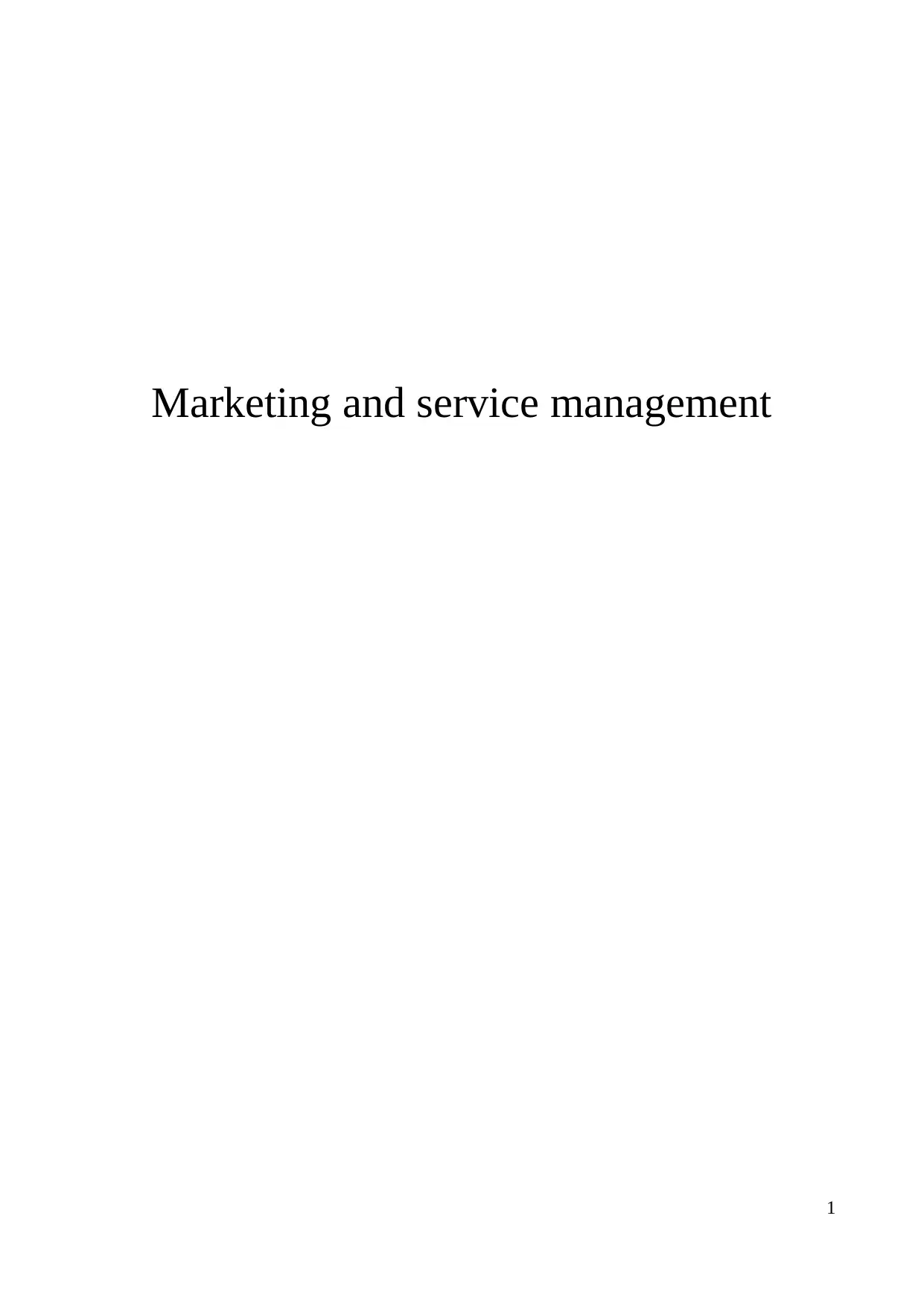
Marketing and service management
1
1
Paraphrase This Document
Need a fresh take? Get an instant paraphrase of this document with our AI Paraphraser
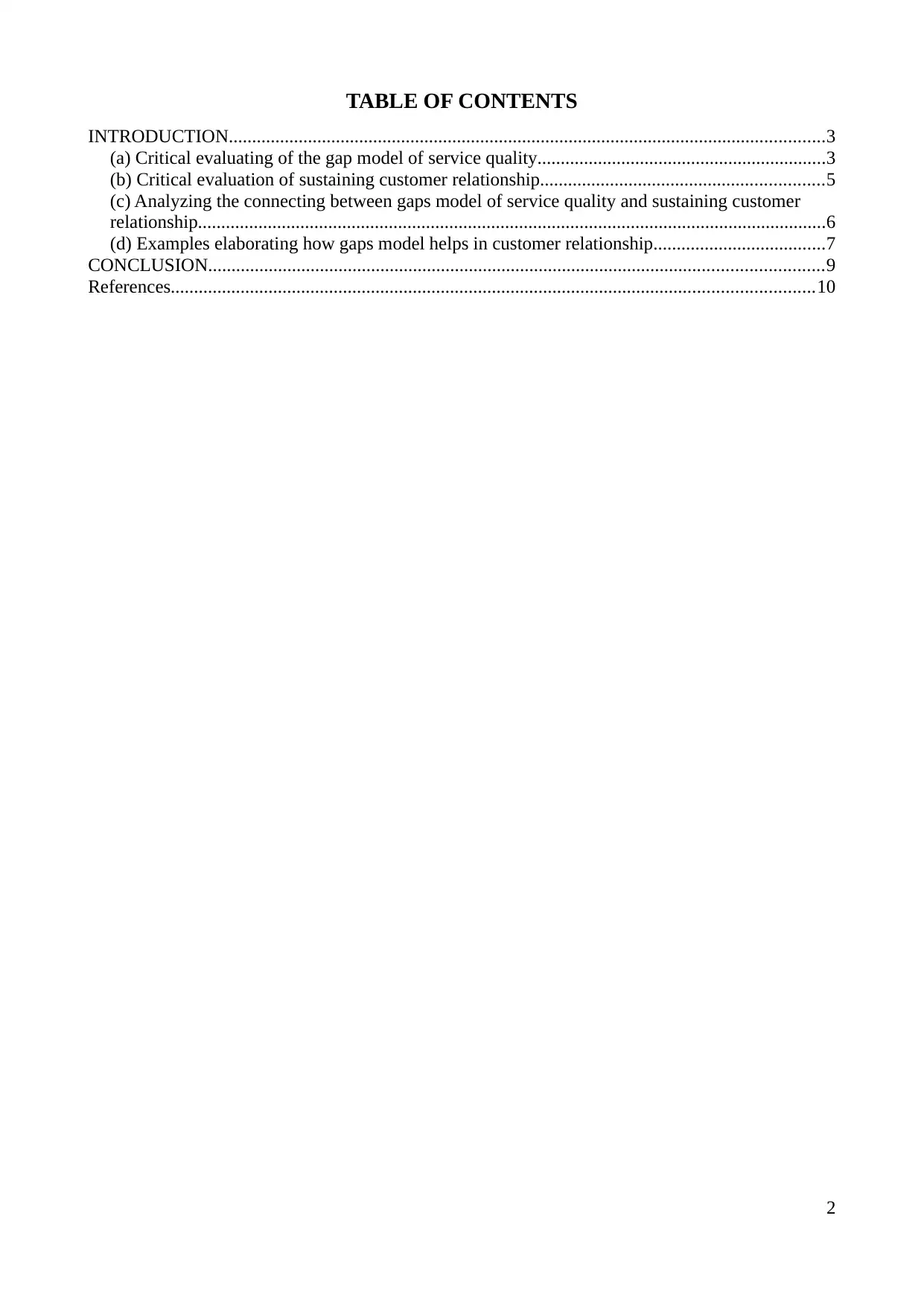
TABLE OF CONTENTS
INTRODUCTION................................................................................................................................3
(a) Critical evaluating of the gap model of service quality..............................................................3
(b) Critical evaluation of sustaining customer relationship.............................................................5
(c) Analyzing the connecting between gaps model of service quality and sustaining customer
relationship.......................................................................................................................................6
(d) Examples elaborating how gaps model helps in customer relationship.....................................7
CONCLUSION....................................................................................................................................9
References..........................................................................................................................................10
2
INTRODUCTION................................................................................................................................3
(a) Critical evaluating of the gap model of service quality..............................................................3
(b) Critical evaluation of sustaining customer relationship.............................................................5
(c) Analyzing the connecting between gaps model of service quality and sustaining customer
relationship.......................................................................................................................................6
(d) Examples elaborating how gaps model helps in customer relationship.....................................7
CONCLUSION....................................................................................................................................9
References..........................................................................................................................................10
2
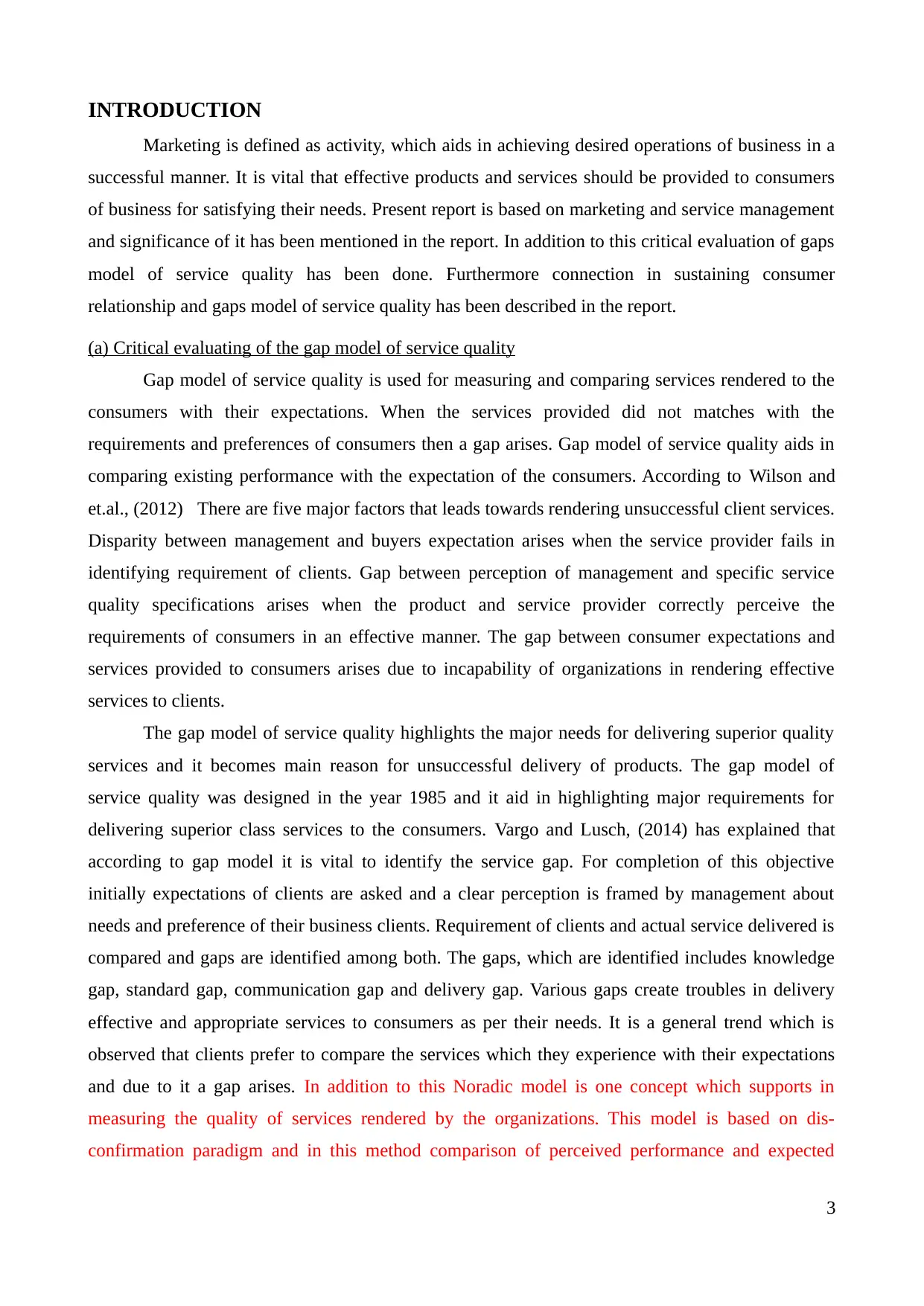
INTRODUCTION
Marketing is defined as activity, which aids in achieving desired operations of business in a
successful manner. It is vital that effective products and services should be provided to consumers
of business for satisfying their needs. Present report is based on marketing and service management
and significance of it has been mentioned in the report. In addition to this critical evaluation of gaps
model of service quality has been done. Furthermore connection in sustaining consumer
relationship and gaps model of service quality has been described in the report.
(a) Critical evaluating of the gap model of service quality
Gap model of service quality is used for measuring and comparing services rendered to the
consumers with their expectations. When the services provided did not matches with the
requirements and preferences of consumers then a gap arises. Gap model of service quality aids in
comparing existing performance with the expectation of the consumers. According to Wilson and
et.al., (2012) There are five major factors that leads towards rendering unsuccessful client services.
Disparity between management and buyers expectation arises when the service provider fails in
identifying requirement of clients. Gap between perception of management and specific service
quality specifications arises when the product and service provider correctly perceive the
requirements of consumers in an effective manner. The gap between consumer expectations and
services provided to consumers arises due to incapability of organizations in rendering effective
services to clients.
The gap model of service quality highlights the major needs for delivering superior quality
services and it becomes main reason for unsuccessful delivery of products. The gap model of
service quality was designed in the year 1985 and it aid in highlighting major requirements for
delivering superior class services to the consumers. Vargo and Lusch, (2014) has explained that
according to gap model it is vital to identify the service gap. For completion of this objective
initially expectations of clients are asked and a clear perception is framed by management about
needs and preference of their business clients. Requirement of clients and actual service delivered is
compared and gaps are identified among both. The gaps, which are identified includes knowledge
gap, standard gap, communication gap and delivery gap. Various gaps create troubles in delivery
effective and appropriate services to consumers as per their needs. It is a general trend which is
observed that clients prefer to compare the services which they experience with their expectations
and due to it a gap arises. In addition to this Noradic model is one concept which supports in
measuring the quality of services rendered by the organizations. This model is based on dis-
confirmation paradigm and in this method comparison of perceived performance and expected
3
Marketing is defined as activity, which aids in achieving desired operations of business in a
successful manner. It is vital that effective products and services should be provided to consumers
of business for satisfying their needs. Present report is based on marketing and service management
and significance of it has been mentioned in the report. In addition to this critical evaluation of gaps
model of service quality has been done. Furthermore connection in sustaining consumer
relationship and gaps model of service quality has been described in the report.
(a) Critical evaluating of the gap model of service quality
Gap model of service quality is used for measuring and comparing services rendered to the
consumers with their expectations. When the services provided did not matches with the
requirements and preferences of consumers then a gap arises. Gap model of service quality aids in
comparing existing performance with the expectation of the consumers. According to Wilson and
et.al., (2012) There are five major factors that leads towards rendering unsuccessful client services.
Disparity between management and buyers expectation arises when the service provider fails in
identifying requirement of clients. Gap between perception of management and specific service
quality specifications arises when the product and service provider correctly perceive the
requirements of consumers in an effective manner. The gap between consumer expectations and
services provided to consumers arises due to incapability of organizations in rendering effective
services to clients.
The gap model of service quality highlights the major needs for delivering superior quality
services and it becomes main reason for unsuccessful delivery of products. The gap model of
service quality was designed in the year 1985 and it aid in highlighting major requirements for
delivering superior class services to the consumers. Vargo and Lusch, (2014) has explained that
according to gap model it is vital to identify the service gap. For completion of this objective
initially expectations of clients are asked and a clear perception is framed by management about
needs and preference of their business clients. Requirement of clients and actual service delivered is
compared and gaps are identified among both. The gaps, which are identified includes knowledge
gap, standard gap, communication gap and delivery gap. Various gaps create troubles in delivery
effective and appropriate services to consumers as per their needs. It is a general trend which is
observed that clients prefer to compare the services which they experience with their expectations
and due to it a gap arises. In addition to this Noradic model is one concept which supports in
measuring the quality of services rendered by the organizations. This model is based on dis-
confirmation paradigm and in this method comparison of perceived performance and expected
3
⊘ This is a preview!⊘
Do you want full access?
Subscribe today to unlock all pages.

Trusted by 1+ million students worldwide
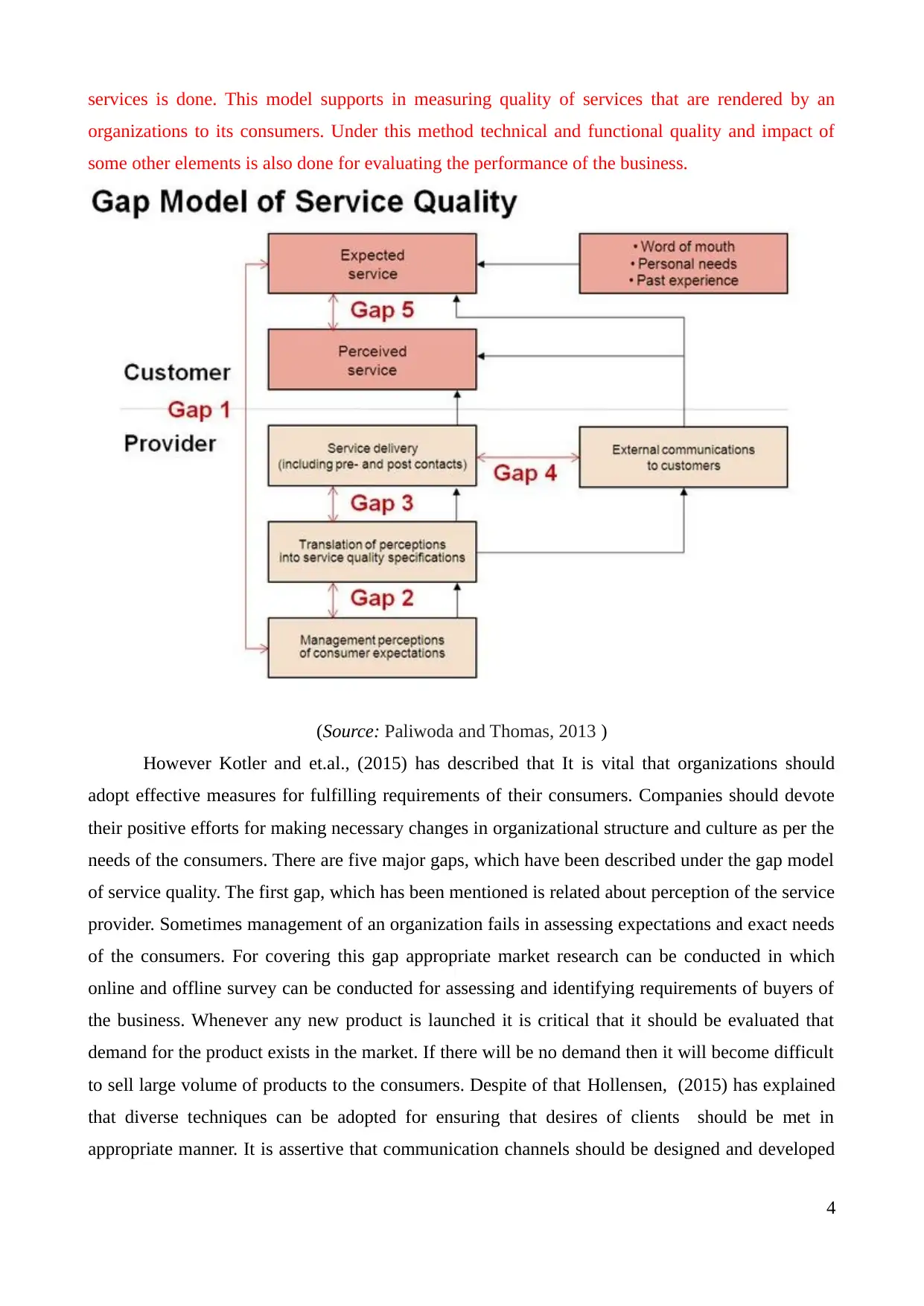
services is done. This model supports in measuring quality of services that are rendered by an
organizations to its consumers. Under this method technical and functional quality and impact of
some other elements is also done for evaluating the performance of the business.
(Source: Paliwoda and Thomas, 2013 )
However Kotler and et.al., (2015) has described that It is vital that organizations should
adopt effective measures for fulfilling requirements of their consumers. Companies should devote
their positive efforts for making necessary changes in organizational structure and culture as per the
needs of the consumers. There are five major gaps, which have been described under the gap model
of service quality. The first gap, which has been mentioned is related about perception of the service
provider. Sometimes management of an organization fails in assessing expectations and exact needs
of the consumers. For covering this gap appropriate market research can be conducted in which
online and offline survey can be conducted for assessing and identifying requirements of buyers of
the business. Whenever any new product is launched it is critical that it should be evaluated that
demand for the product exists in the market. If there will be no demand then it will become difficult
to sell large volume of products to the consumers. Despite of that Hollensen, (2015) has explained
that diverse techniques can be adopted for ensuring that desires of clients should be met in
appropriate manner. It is assertive that communication channels should be designed and developed
4
organizations to its consumers. Under this method technical and functional quality and impact of
some other elements is also done for evaluating the performance of the business.
(Source: Paliwoda and Thomas, 2013 )
However Kotler and et.al., (2015) has described that It is vital that organizations should
adopt effective measures for fulfilling requirements of their consumers. Companies should devote
their positive efforts for making necessary changes in organizational structure and culture as per the
needs of the consumers. There are five major gaps, which have been described under the gap model
of service quality. The first gap, which has been mentioned is related about perception of the service
provider. Sometimes management of an organization fails in assessing expectations and exact needs
of the consumers. For covering this gap appropriate market research can be conducted in which
online and offline survey can be conducted for assessing and identifying requirements of buyers of
the business. Whenever any new product is launched it is critical that it should be evaluated that
demand for the product exists in the market. If there will be no demand then it will become difficult
to sell large volume of products to the consumers. Despite of that Hollensen, (2015) has explained
that diverse techniques can be adopted for ensuring that desires of clients should be met in
appropriate manner. It is assertive that communication channels should be designed and developed
4
Paraphrase This Document
Need a fresh take? Get an instant paraphrase of this document with our AI Paraphraser
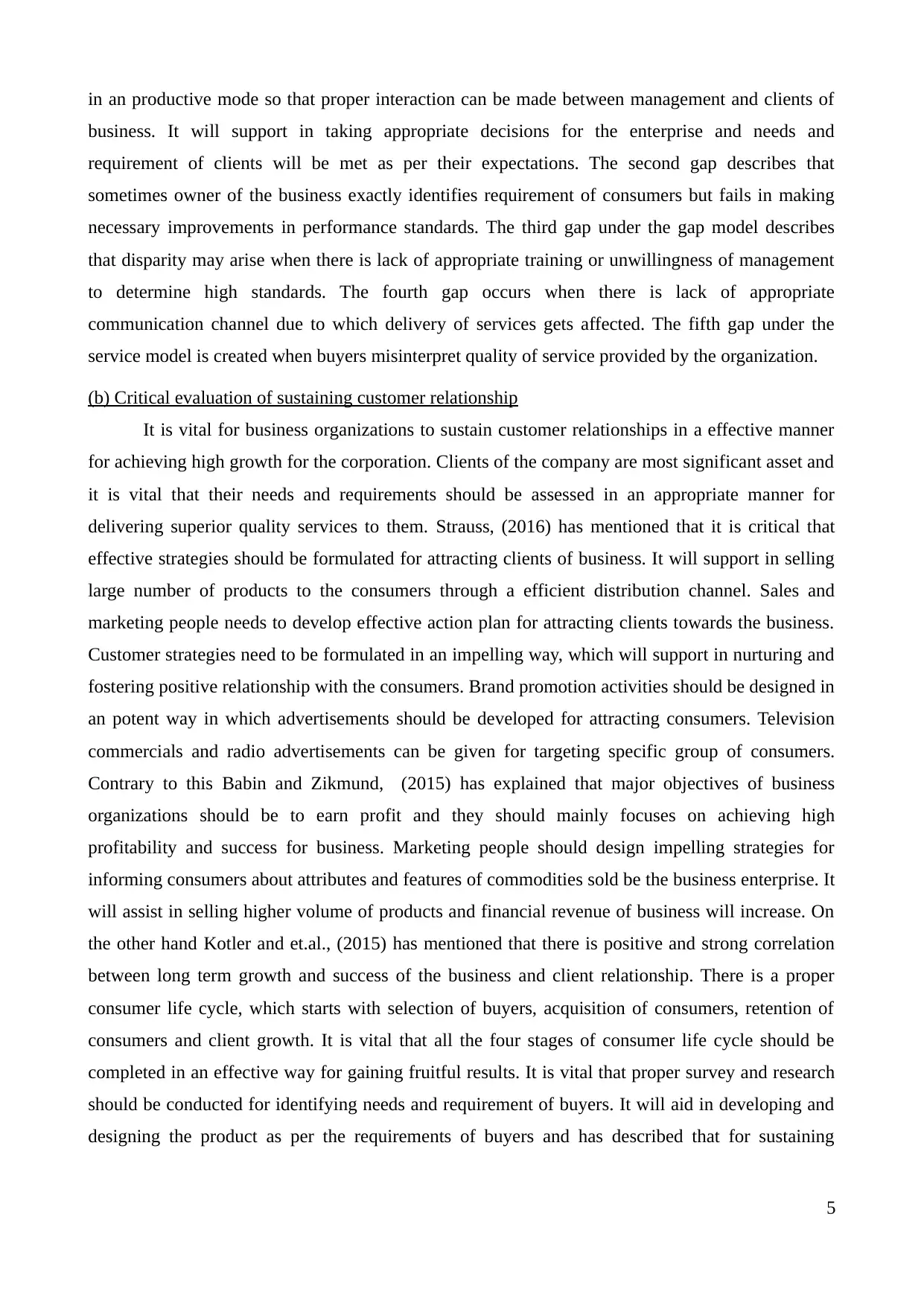
in an productive mode so that proper interaction can be made between management and clients of
business. It will support in taking appropriate decisions for the enterprise and needs and
requirement of clients will be met as per their expectations. The second gap describes that
sometimes owner of the business exactly identifies requirement of consumers but fails in making
necessary improvements in performance standards. The third gap under the gap model describes
that disparity may arise when there is lack of appropriate training or unwillingness of management
to determine high standards. The fourth gap occurs when there is lack of appropriate
communication channel due to which delivery of services gets affected. The fifth gap under the
service model is created when buyers misinterpret quality of service provided by the organization.
(b) Critical evaluation of sustaining customer relationship
It is vital for business organizations to sustain customer relationships in a effective manner
for achieving high growth for the corporation. Clients of the company are most significant asset and
it is vital that their needs and requirements should be assessed in an appropriate manner for
delivering superior quality services to them. Strauss, (2016) has mentioned that it is critical that
effective strategies should be formulated for attracting clients of business. It will support in selling
large number of products to the consumers through a efficient distribution channel. Sales and
marketing people needs to develop effective action plan for attracting clients towards the business.
Customer strategies need to be formulated in an impelling way, which will support in nurturing and
fostering positive relationship with the consumers. Brand promotion activities should be designed in
an potent way in which advertisements should be developed for attracting consumers. Television
commercials and radio advertisements can be given for targeting specific group of consumers.
Contrary to this Babin and Zikmund, (2015) has explained that major objectives of business
organizations should be to earn profit and they should mainly focuses on achieving high
profitability and success for business. Marketing people should design impelling strategies for
informing consumers about attributes and features of commodities sold be the business enterprise. It
will assist in selling higher volume of products and financial revenue of business will increase. On
the other hand Kotler and et.al., (2015) has mentioned that there is positive and strong correlation
between long term growth and success of the business and client relationship. There is a proper
consumer life cycle, which starts with selection of buyers, acquisition of consumers, retention of
consumers and client growth. It is vital that all the four stages of consumer life cycle should be
completed in an effective way for gaining fruitful results. It is vital that proper survey and research
should be conducted for identifying needs and requirement of buyers. It will aid in developing and
designing the product as per the requirements of buyers and has described that for sustaining
5
business. It will support in taking appropriate decisions for the enterprise and needs and
requirement of clients will be met as per their expectations. The second gap describes that
sometimes owner of the business exactly identifies requirement of consumers but fails in making
necessary improvements in performance standards. The third gap under the gap model describes
that disparity may arise when there is lack of appropriate training or unwillingness of management
to determine high standards. The fourth gap occurs when there is lack of appropriate
communication channel due to which delivery of services gets affected. The fifth gap under the
service model is created when buyers misinterpret quality of service provided by the organization.
(b) Critical evaluation of sustaining customer relationship
It is vital for business organizations to sustain customer relationships in a effective manner
for achieving high growth for the corporation. Clients of the company are most significant asset and
it is vital that their needs and requirements should be assessed in an appropriate manner for
delivering superior quality services to them. Strauss, (2016) has mentioned that it is critical that
effective strategies should be formulated for attracting clients of business. It will support in selling
large number of products to the consumers through a efficient distribution channel. Sales and
marketing people needs to develop effective action plan for attracting clients towards the business.
Customer strategies need to be formulated in an impelling way, which will support in nurturing and
fostering positive relationship with the consumers. Brand promotion activities should be designed in
an potent way in which advertisements should be developed for attracting consumers. Television
commercials and radio advertisements can be given for targeting specific group of consumers.
Contrary to this Babin and Zikmund, (2015) has explained that major objectives of business
organizations should be to earn profit and they should mainly focuses on achieving high
profitability and success for business. Marketing people should design impelling strategies for
informing consumers about attributes and features of commodities sold be the business enterprise. It
will assist in selling higher volume of products and financial revenue of business will increase. On
the other hand Kotler and et.al., (2015) has mentioned that there is positive and strong correlation
between long term growth and success of the business and client relationship. There is a proper
consumer life cycle, which starts with selection of buyers, acquisition of consumers, retention of
consumers and client growth. It is vital that all the four stages of consumer life cycle should be
completed in an effective way for gaining fruitful results. It is vital that proper survey and research
should be conducted for identifying needs and requirement of buyers. It will aid in developing and
designing the product as per the requirements of buyers and has described that for sustaining
5
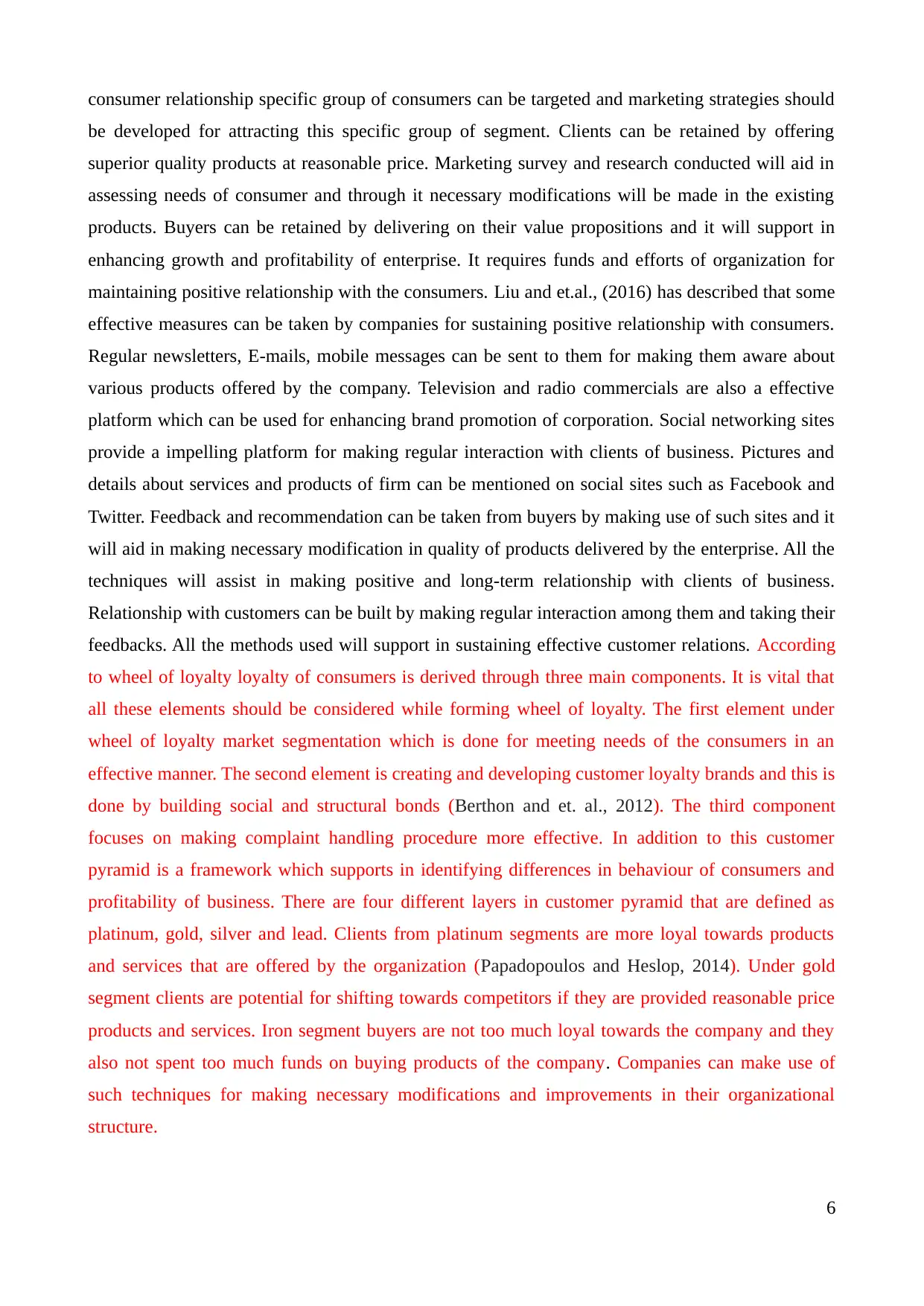
consumer relationship specific group of consumers can be targeted and marketing strategies should
be developed for attracting this specific group of segment. Clients can be retained by offering
superior quality products at reasonable price. Marketing survey and research conducted will aid in
assessing needs of consumer and through it necessary modifications will be made in the existing
products. Buyers can be retained by delivering on their value propositions and it will support in
enhancing growth and profitability of enterprise. It requires funds and efforts of organization for
maintaining positive relationship with the consumers. Liu and et.al., (2016) has described that some
effective measures can be taken by companies for sustaining positive relationship with consumers.
Regular newsletters, E-mails, mobile messages can be sent to them for making them aware about
various products offered by the company. Television and radio commercials are also a effective
platform which can be used for enhancing brand promotion of corporation. Social networking sites
provide a impelling platform for making regular interaction with clients of business. Pictures and
details about services and products of firm can be mentioned on social sites such as Facebook and
Twitter. Feedback and recommendation can be taken from buyers by making use of such sites and it
will aid in making necessary modification in quality of products delivered by the enterprise. All the
techniques will assist in making positive and long-term relationship with clients of business.
Relationship with customers can be built by making regular interaction among them and taking their
feedbacks. All the methods used will support in sustaining effective customer relations. According
to wheel of loyalty loyalty of consumers is derived through three main components. It is vital that
all these elements should be considered while forming wheel of loyalty. The first element under
wheel of loyalty market segmentation which is done for meeting needs of the consumers in an
effective manner. The second element is creating and developing customer loyalty brands and this is
done by building social and structural bonds (Berthon and et. al., 2012). The third component
focuses on making complaint handling procedure more effective. In addition to this customer
pyramid is a framework which supports in identifying differences in behaviour of consumers and
profitability of business. There are four different layers in customer pyramid that are defined as
platinum, gold, silver and lead. Clients from platinum segments are more loyal towards products
and services that are offered by the organization (Papadopoulos and Heslop, 2014). Under gold
segment clients are potential for shifting towards competitors if they are provided reasonable price
products and services. Iron segment buyers are not too much loyal towards the company and they
also not spent too much funds on buying products of the company. Companies can make use of
such techniques for making necessary modifications and improvements in their organizational
structure.
6
be developed for attracting this specific group of segment. Clients can be retained by offering
superior quality products at reasonable price. Marketing survey and research conducted will aid in
assessing needs of consumer and through it necessary modifications will be made in the existing
products. Buyers can be retained by delivering on their value propositions and it will support in
enhancing growth and profitability of enterprise. It requires funds and efforts of organization for
maintaining positive relationship with the consumers. Liu and et.al., (2016) has described that some
effective measures can be taken by companies for sustaining positive relationship with consumers.
Regular newsletters, E-mails, mobile messages can be sent to them for making them aware about
various products offered by the company. Television and radio commercials are also a effective
platform which can be used for enhancing brand promotion of corporation. Social networking sites
provide a impelling platform for making regular interaction with clients of business. Pictures and
details about services and products of firm can be mentioned on social sites such as Facebook and
Twitter. Feedback and recommendation can be taken from buyers by making use of such sites and it
will aid in making necessary modification in quality of products delivered by the enterprise. All the
techniques will assist in making positive and long-term relationship with clients of business.
Relationship with customers can be built by making regular interaction among them and taking their
feedbacks. All the methods used will support in sustaining effective customer relations. According
to wheel of loyalty loyalty of consumers is derived through three main components. It is vital that
all these elements should be considered while forming wheel of loyalty. The first element under
wheel of loyalty market segmentation which is done for meeting needs of the consumers in an
effective manner. The second element is creating and developing customer loyalty brands and this is
done by building social and structural bonds (Berthon and et. al., 2012). The third component
focuses on making complaint handling procedure more effective. In addition to this customer
pyramid is a framework which supports in identifying differences in behaviour of consumers and
profitability of business. There are four different layers in customer pyramid that are defined as
platinum, gold, silver and lead. Clients from platinum segments are more loyal towards products
and services that are offered by the organization (Papadopoulos and Heslop, 2014). Under gold
segment clients are potential for shifting towards competitors if they are provided reasonable price
products and services. Iron segment buyers are not too much loyal towards the company and they
also not spent too much funds on buying products of the company. Companies can make use of
such techniques for making necessary modifications and improvements in their organizational
structure.
6
⊘ This is a preview!⊘
Do you want full access?
Subscribe today to unlock all pages.

Trusted by 1+ million students worldwide
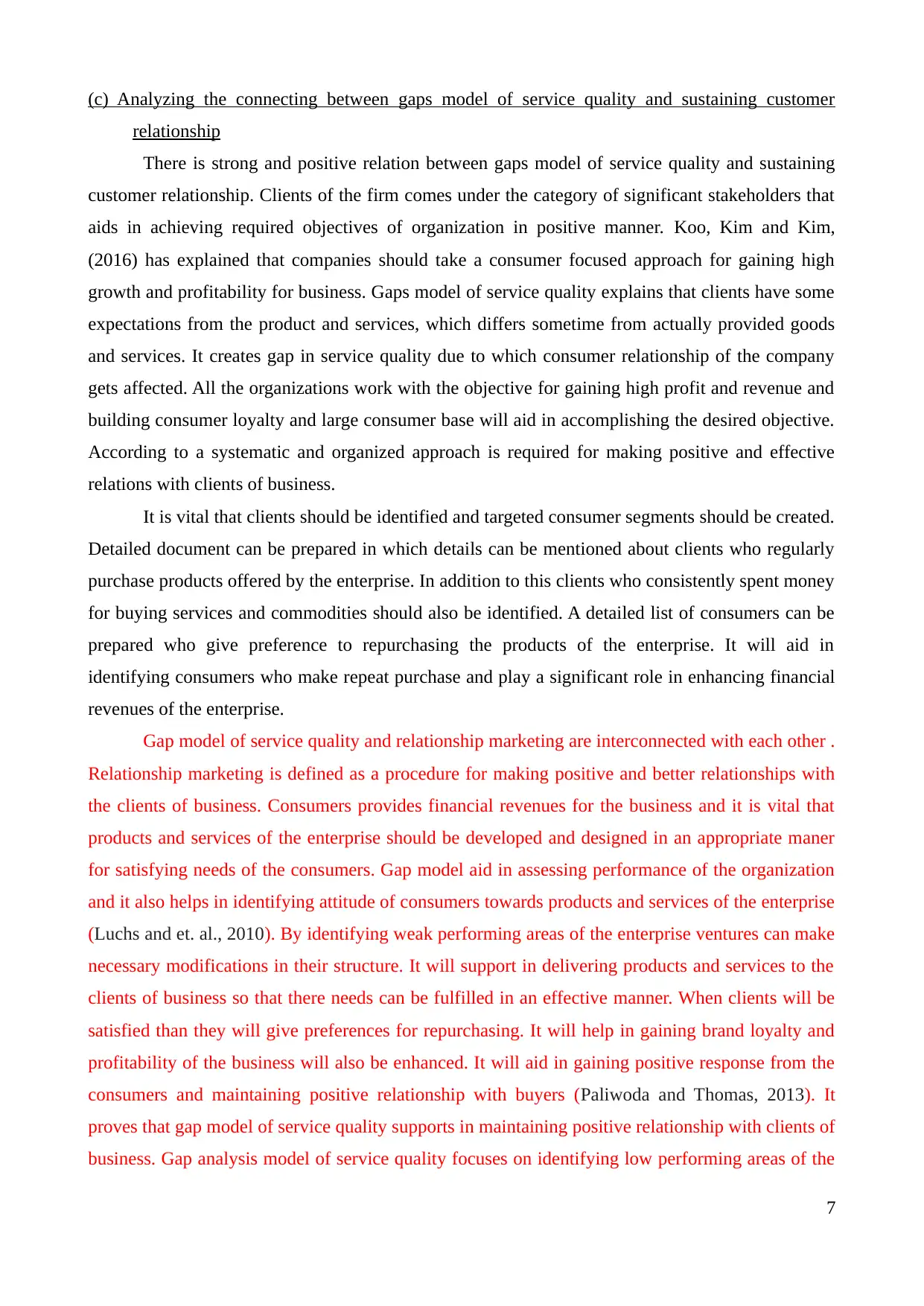
(c) Analyzing the connecting between gaps model of service quality and sustaining customer
relationship
There is strong and positive relation between gaps model of service quality and sustaining
customer relationship. Clients of the firm comes under the category of significant stakeholders that
aids in achieving required objectives of organization in positive manner. Koo, Kim and Kim,
(2016) has explained that companies should take a consumer focused approach for gaining high
growth and profitability for business. Gaps model of service quality explains that clients have some
expectations from the product and services, which differs sometime from actually provided goods
and services. It creates gap in service quality due to which consumer relationship of the company
gets affected. All the organizations work with the objective for gaining high profit and revenue and
building consumer loyalty and large consumer base will aid in accomplishing the desired objective.
According to a systematic and organized approach is required for making positive and effective
relations with clients of business.
It is vital that clients should be identified and targeted consumer segments should be created.
Detailed document can be prepared in which details can be mentioned about clients who regularly
purchase products offered by the enterprise. In addition to this clients who consistently spent money
for buying services and commodities should also be identified. A detailed list of consumers can be
prepared who give preference to repurchasing the products of the enterprise. It will aid in
identifying consumers who make repeat purchase and play a significant role in enhancing financial
revenues of the enterprise.
Gap model of service quality and relationship marketing are interconnected with each other .
Relationship marketing is defined as a procedure for making positive and better relationships with
the clients of business. Consumers provides financial revenues for the business and it is vital that
products and services of the enterprise should be developed and designed in an appropriate maner
for satisfying needs of the consumers. Gap model aid in assessing performance of the organization
and it also helps in identifying attitude of consumers towards products and services of the enterprise
(Luchs and et. al., 2010). By identifying weak performing areas of the enterprise ventures can make
necessary modifications in their structure. It will support in delivering products and services to the
clients of business so that there needs can be fulfilled in an effective manner. When clients will be
satisfied than they will give preferences for repurchasing. It will help in gaining brand loyalty and
profitability of the business will also be enhanced. It will aid in gaining positive response from the
consumers and maintaining positive relationship with buyers (Paliwoda and Thomas, 2013). It
proves that gap model of service quality supports in maintaining positive relationship with clients of
business. Gap analysis model of service quality focuses on identifying low performing areas of the
7
relationship
There is strong and positive relation between gaps model of service quality and sustaining
customer relationship. Clients of the firm comes under the category of significant stakeholders that
aids in achieving required objectives of organization in positive manner. Koo, Kim and Kim,
(2016) has explained that companies should take a consumer focused approach for gaining high
growth and profitability for business. Gaps model of service quality explains that clients have some
expectations from the product and services, which differs sometime from actually provided goods
and services. It creates gap in service quality due to which consumer relationship of the company
gets affected. All the organizations work with the objective for gaining high profit and revenue and
building consumer loyalty and large consumer base will aid in accomplishing the desired objective.
According to a systematic and organized approach is required for making positive and effective
relations with clients of business.
It is vital that clients should be identified and targeted consumer segments should be created.
Detailed document can be prepared in which details can be mentioned about clients who regularly
purchase products offered by the enterprise. In addition to this clients who consistently spent money
for buying services and commodities should also be identified. A detailed list of consumers can be
prepared who give preference to repurchasing the products of the enterprise. It will aid in
identifying consumers who make repeat purchase and play a significant role in enhancing financial
revenues of the enterprise.
Gap model of service quality and relationship marketing are interconnected with each other .
Relationship marketing is defined as a procedure for making positive and better relationships with
the clients of business. Consumers provides financial revenues for the business and it is vital that
products and services of the enterprise should be developed and designed in an appropriate maner
for satisfying needs of the consumers. Gap model aid in assessing performance of the organization
and it also helps in identifying attitude of consumers towards products and services of the enterprise
(Luchs and et. al., 2010). By identifying weak performing areas of the enterprise ventures can make
necessary modifications in their structure. It will support in delivering products and services to the
clients of business so that there needs can be fulfilled in an effective manner. When clients will be
satisfied than they will give preferences for repurchasing. It will help in gaining brand loyalty and
profitability of the business will also be enhanced. It will aid in gaining positive response from the
consumers and maintaining positive relationship with buyers (Paliwoda and Thomas, 2013). It
proves that gap model of service quality supports in maintaining positive relationship with clients of
business. Gap analysis model of service quality focuses on identifying low performing areas of the
7
Paraphrase This Document
Need a fresh take? Get an instant paraphrase of this document with our AI Paraphraser
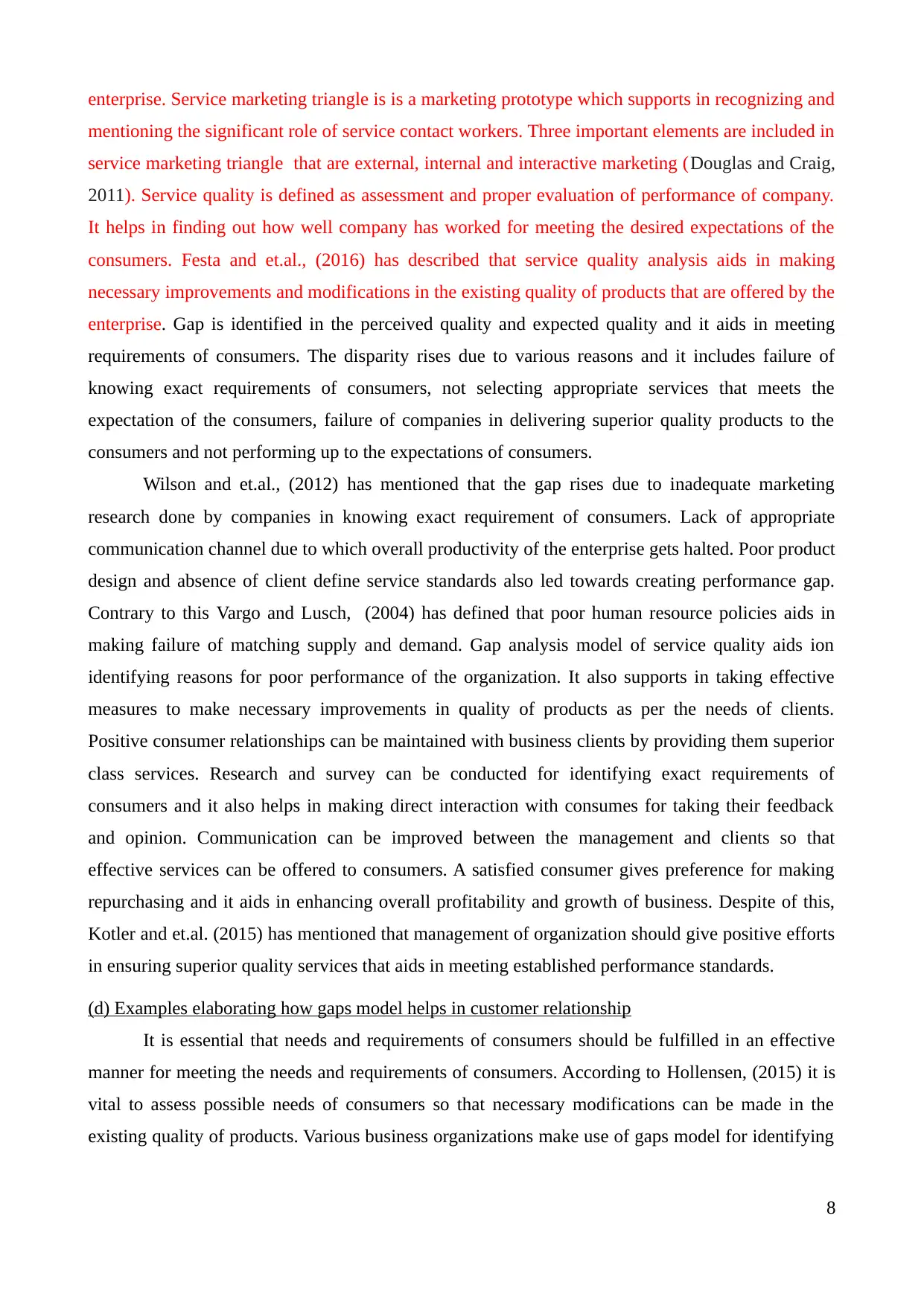
enterprise. Service marketing triangle is is a marketing prototype which supports in recognizing and
mentioning the significant role of service contact workers. Three important elements are included in
service marketing triangle that are external, internal and interactive marketing (Douglas and Craig,
2011). Service quality is defined as assessment and proper evaluation of performance of company.
It helps in finding out how well company has worked for meeting the desired expectations of the
consumers. Festa and et.al., (2016) has described that service quality analysis aids in making
necessary improvements and modifications in the existing quality of products that are offered by the
enterprise. Gap is identified in the perceived quality and expected quality and it aids in meeting
requirements of consumers. The disparity rises due to various reasons and it includes failure of
knowing exact requirements of consumers, not selecting appropriate services that meets the
expectation of the consumers, failure of companies in delivering superior quality products to the
consumers and not performing up to the expectations of consumers.
Wilson and et.al., (2012) has mentioned that the gap rises due to inadequate marketing
research done by companies in knowing exact requirement of consumers. Lack of appropriate
communication channel due to which overall productivity of the enterprise gets halted. Poor product
design and absence of client define service standards also led towards creating performance gap.
Contrary to this Vargo and Lusch, (2004) has defined that poor human resource policies aids in
making failure of matching supply and demand. Gap analysis model of service quality aids ion
identifying reasons for poor performance of the organization. It also supports in taking effective
measures to make necessary improvements in quality of products as per the needs of clients.
Positive consumer relationships can be maintained with business clients by providing them superior
class services. Research and survey can be conducted for identifying exact requirements of
consumers and it also helps in making direct interaction with consumes for taking their feedback
and opinion. Communication can be improved between the management and clients so that
effective services can be offered to consumers. A satisfied consumer gives preference for making
repurchasing and it aids in enhancing overall profitability and growth of business. Despite of this,
Kotler and et.al. (2015) has mentioned that management of organization should give positive efforts
in ensuring superior quality services that aids in meeting established performance standards.
(d) Examples elaborating how gaps model helps in customer relationship
It is essential that needs and requirements of consumers should be fulfilled in an effective
manner for meeting the needs and requirements of consumers. According to Hollensen, (2015) it is
vital to assess possible needs of consumers so that necessary modifications can be made in the
existing quality of products. Various business organizations make use of gaps model for identifying
8
mentioning the significant role of service contact workers. Three important elements are included in
service marketing triangle that are external, internal and interactive marketing (Douglas and Craig,
2011). Service quality is defined as assessment and proper evaluation of performance of company.
It helps in finding out how well company has worked for meeting the desired expectations of the
consumers. Festa and et.al., (2016) has described that service quality analysis aids in making
necessary improvements and modifications in the existing quality of products that are offered by the
enterprise. Gap is identified in the perceived quality and expected quality and it aids in meeting
requirements of consumers. The disparity rises due to various reasons and it includes failure of
knowing exact requirements of consumers, not selecting appropriate services that meets the
expectation of the consumers, failure of companies in delivering superior quality products to the
consumers and not performing up to the expectations of consumers.
Wilson and et.al., (2012) has mentioned that the gap rises due to inadequate marketing
research done by companies in knowing exact requirement of consumers. Lack of appropriate
communication channel due to which overall productivity of the enterprise gets halted. Poor product
design and absence of client define service standards also led towards creating performance gap.
Contrary to this Vargo and Lusch, (2004) has defined that poor human resource policies aids in
making failure of matching supply and demand. Gap analysis model of service quality aids ion
identifying reasons for poor performance of the organization. It also supports in taking effective
measures to make necessary improvements in quality of products as per the needs of clients.
Positive consumer relationships can be maintained with business clients by providing them superior
class services. Research and survey can be conducted for identifying exact requirements of
consumers and it also helps in making direct interaction with consumes for taking their feedback
and opinion. Communication can be improved between the management and clients so that
effective services can be offered to consumers. A satisfied consumer gives preference for making
repurchasing and it aids in enhancing overall profitability and growth of business. Despite of this,
Kotler and et.al. (2015) has mentioned that management of organization should give positive efforts
in ensuring superior quality services that aids in meeting established performance standards.
(d) Examples elaborating how gaps model helps in customer relationship
It is essential that needs and requirements of consumers should be fulfilled in an effective
manner for meeting the needs and requirements of consumers. According to Hollensen, (2015) it is
vital to assess possible needs of consumers so that necessary modifications can be made in the
existing quality of products. Various business organizations make use of gaps model for identifying
8
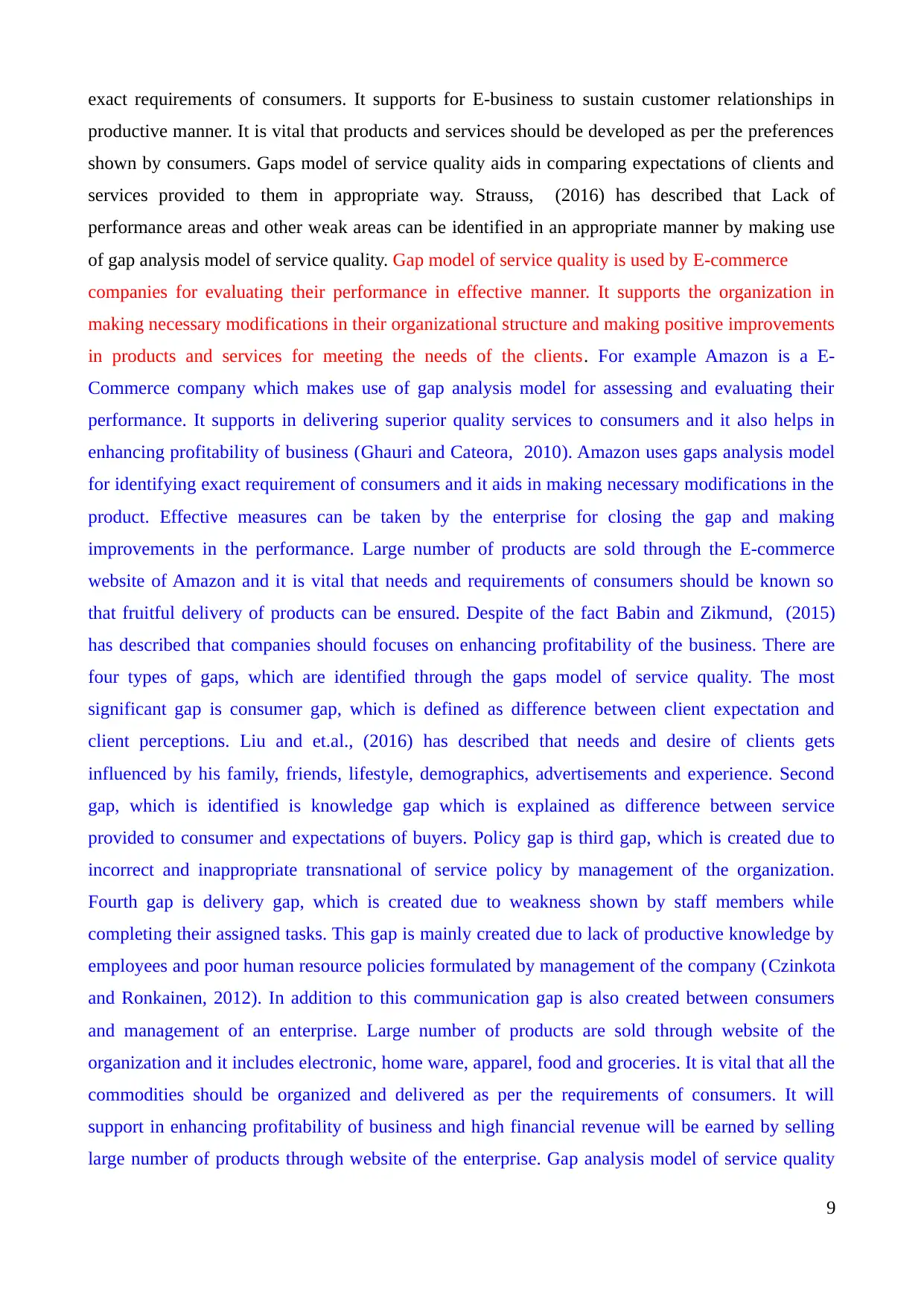
exact requirements of consumers. It supports for E-business to sustain customer relationships in
productive manner. It is vital that products and services should be developed as per the preferences
shown by consumers. Gaps model of service quality aids in comparing expectations of clients and
services provided to them in appropriate way. Strauss, (2016) has described that Lack of
performance areas and other weak areas can be identified in an appropriate manner by making use
of gap analysis model of service quality. Gap model of service quality is used by E-commerce
companies for evaluating their performance in effective manner. It supports the organization in
making necessary modifications in their organizational structure and making positive improvements
in products and services for meeting the needs of the clients. For example Amazon is a E-
Commerce company which makes use of gap analysis model for assessing and evaluating their
performance. It supports in delivering superior quality services to consumers and it also helps in
enhancing profitability of business (Ghauri and Cateora, 2010). Amazon uses gaps analysis model
for identifying exact requirement of consumers and it aids in making necessary modifications in the
product. Effective measures can be taken by the enterprise for closing the gap and making
improvements in the performance. Large number of products are sold through the E-commerce
website of Amazon and it is vital that needs and requirements of consumers should be known so
that fruitful delivery of products can be ensured. Despite of the fact Babin and Zikmund, (2015)
has described that companies should focuses on enhancing profitability of the business. There are
four types of gaps, which are identified through the gaps model of service quality. The most
significant gap is consumer gap, which is defined as difference between client expectation and
client perceptions. Liu and et.al., (2016) has described that needs and desire of clients gets
influenced by his family, friends, lifestyle, demographics, advertisements and experience. Second
gap, which is identified is knowledge gap which is explained as difference between service
provided to consumer and expectations of buyers. Policy gap is third gap, which is created due to
incorrect and inappropriate transnational of service policy by management of the organization.
Fourth gap is delivery gap, which is created due to weakness shown by staff members while
completing their assigned tasks. This gap is mainly created due to lack of productive knowledge by
employees and poor human resource policies formulated by management of the company (Czinkota
and Ronkainen, 2012). In addition to this communication gap is also created between consumers
and management of an enterprise. Large number of products are sold through website of the
organization and it includes electronic, home ware, apparel, food and groceries. It is vital that all the
commodities should be organized and delivered as per the requirements of consumers. It will
support in enhancing profitability of business and high financial revenue will be earned by selling
large number of products through website of the enterprise. Gap analysis model of service quality
9
productive manner. It is vital that products and services should be developed as per the preferences
shown by consumers. Gaps model of service quality aids in comparing expectations of clients and
services provided to them in appropriate way. Strauss, (2016) has described that Lack of
performance areas and other weak areas can be identified in an appropriate manner by making use
of gap analysis model of service quality. Gap model of service quality is used by E-commerce
companies for evaluating their performance in effective manner. It supports the organization in
making necessary modifications in their organizational structure and making positive improvements
in products and services for meeting the needs of the clients. For example Amazon is a E-
Commerce company which makes use of gap analysis model for assessing and evaluating their
performance. It supports in delivering superior quality services to consumers and it also helps in
enhancing profitability of business (Ghauri and Cateora, 2010). Amazon uses gaps analysis model
for identifying exact requirement of consumers and it aids in making necessary modifications in the
product. Effective measures can be taken by the enterprise for closing the gap and making
improvements in the performance. Large number of products are sold through the E-commerce
website of Amazon and it is vital that needs and requirements of consumers should be known so
that fruitful delivery of products can be ensured. Despite of the fact Babin and Zikmund, (2015)
has described that companies should focuses on enhancing profitability of the business. There are
four types of gaps, which are identified through the gaps model of service quality. The most
significant gap is consumer gap, which is defined as difference between client expectation and
client perceptions. Liu and et.al., (2016) has described that needs and desire of clients gets
influenced by his family, friends, lifestyle, demographics, advertisements and experience. Second
gap, which is identified is knowledge gap which is explained as difference between service
provided to consumer and expectations of buyers. Policy gap is third gap, which is created due to
incorrect and inappropriate transnational of service policy by management of the organization.
Fourth gap is delivery gap, which is created due to weakness shown by staff members while
completing their assigned tasks. This gap is mainly created due to lack of productive knowledge by
employees and poor human resource policies formulated by management of the company (Czinkota
and Ronkainen, 2012). In addition to this communication gap is also created between consumers
and management of an enterprise. Large number of products are sold through website of the
organization and it includes electronic, home ware, apparel, food and groceries. It is vital that all the
commodities should be organized and delivered as per the requirements of consumers. It will
support in enhancing profitability of business and high financial revenue will be earned by selling
large number of products through website of the enterprise. Gap analysis model of service quality
9
⊘ This is a preview!⊘
Do you want full access?
Subscribe today to unlock all pages.

Trusted by 1+ million students worldwide
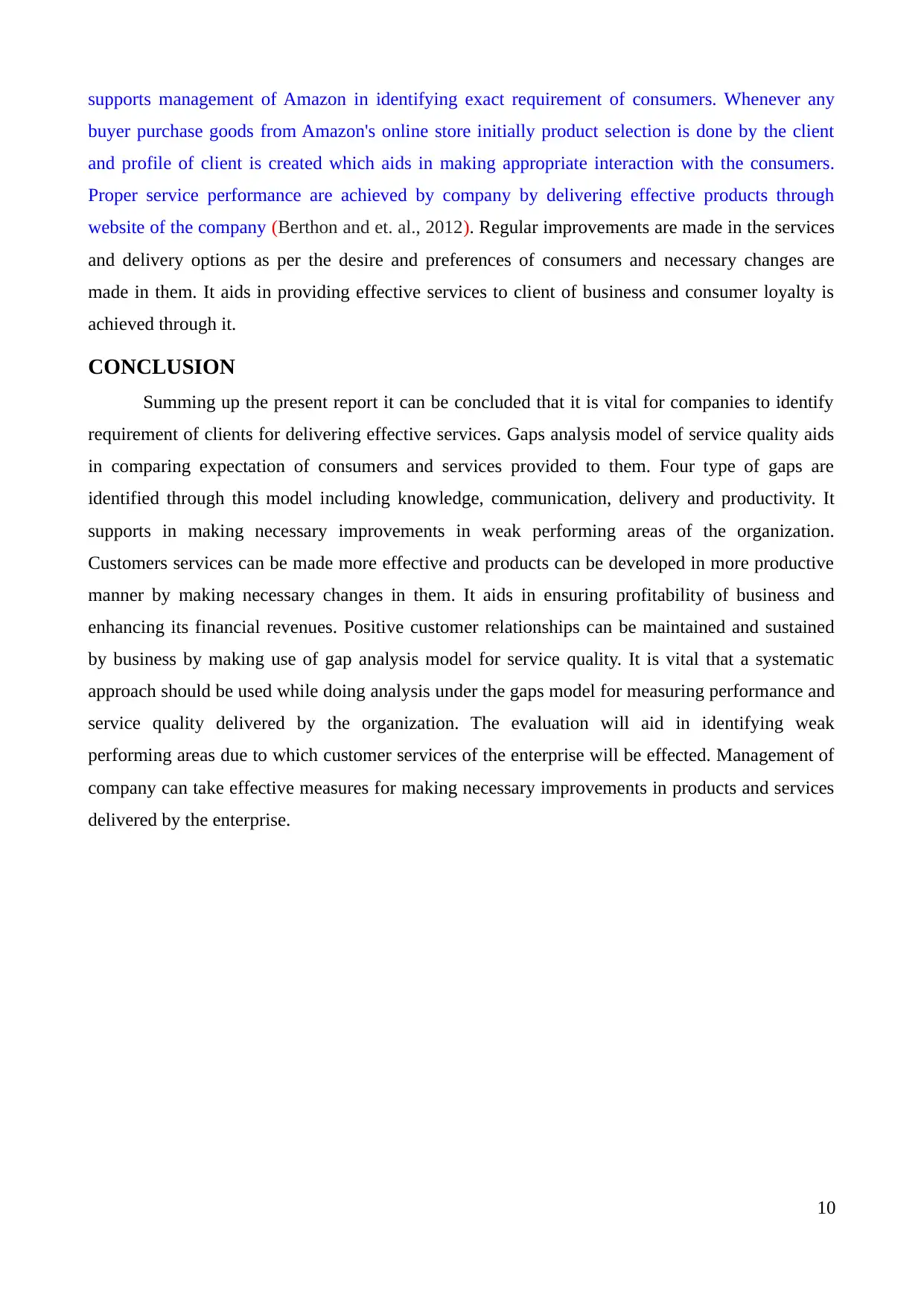
supports management of Amazon in identifying exact requirement of consumers. Whenever any
buyer purchase goods from Amazon's online store initially product selection is done by the client
and profile of client is created which aids in making appropriate interaction with the consumers.
Proper service performance are achieved by company by delivering effective products through
website of the company (Berthon and et. al., 2012). Regular improvements are made in the services
and delivery options as per the desire and preferences of consumers and necessary changes are
made in them. It aids in providing effective services to client of business and consumer loyalty is
achieved through it.
CONCLUSION
Summing up the present report it can be concluded that it is vital for companies to identify
requirement of clients for delivering effective services. Gaps analysis model of service quality aids
in comparing expectation of consumers and services provided to them. Four type of gaps are
identified through this model including knowledge, communication, delivery and productivity. It
supports in making necessary improvements in weak performing areas of the organization.
Customers services can be made more effective and products can be developed in more productive
manner by making necessary changes in them. It aids in ensuring profitability of business and
enhancing its financial revenues. Positive customer relationships can be maintained and sustained
by business by making use of gap analysis model for service quality. It is vital that a systematic
approach should be used while doing analysis under the gaps model for measuring performance and
service quality delivered by the organization. The evaluation will aid in identifying weak
performing areas due to which customer services of the enterprise will be effected. Management of
company can take effective measures for making necessary improvements in products and services
delivered by the enterprise.
10
buyer purchase goods from Amazon's online store initially product selection is done by the client
and profile of client is created which aids in making appropriate interaction with the consumers.
Proper service performance are achieved by company by delivering effective products through
website of the company (Berthon and et. al., 2012). Regular improvements are made in the services
and delivery options as per the desire and preferences of consumers and necessary changes are
made in them. It aids in providing effective services to client of business and consumer loyalty is
achieved through it.
CONCLUSION
Summing up the present report it can be concluded that it is vital for companies to identify
requirement of clients for delivering effective services. Gaps analysis model of service quality aids
in comparing expectation of consumers and services provided to them. Four type of gaps are
identified through this model including knowledge, communication, delivery and productivity. It
supports in making necessary improvements in weak performing areas of the organization.
Customers services can be made more effective and products can be developed in more productive
manner by making necessary changes in them. It aids in ensuring profitability of business and
enhancing its financial revenues. Positive customer relationships can be maintained and sustained
by business by making use of gap analysis model for service quality. It is vital that a systematic
approach should be used while doing analysis under the gaps model for measuring performance and
service quality delivered by the organization. The evaluation will aid in identifying weak
performing areas due to which customer services of the enterprise will be effected. Management of
company can take effective measures for making necessary improvements in products and services
delivered by the enterprise.
10
Paraphrase This Document
Need a fresh take? Get an instant paraphrase of this document with our AI Paraphraser
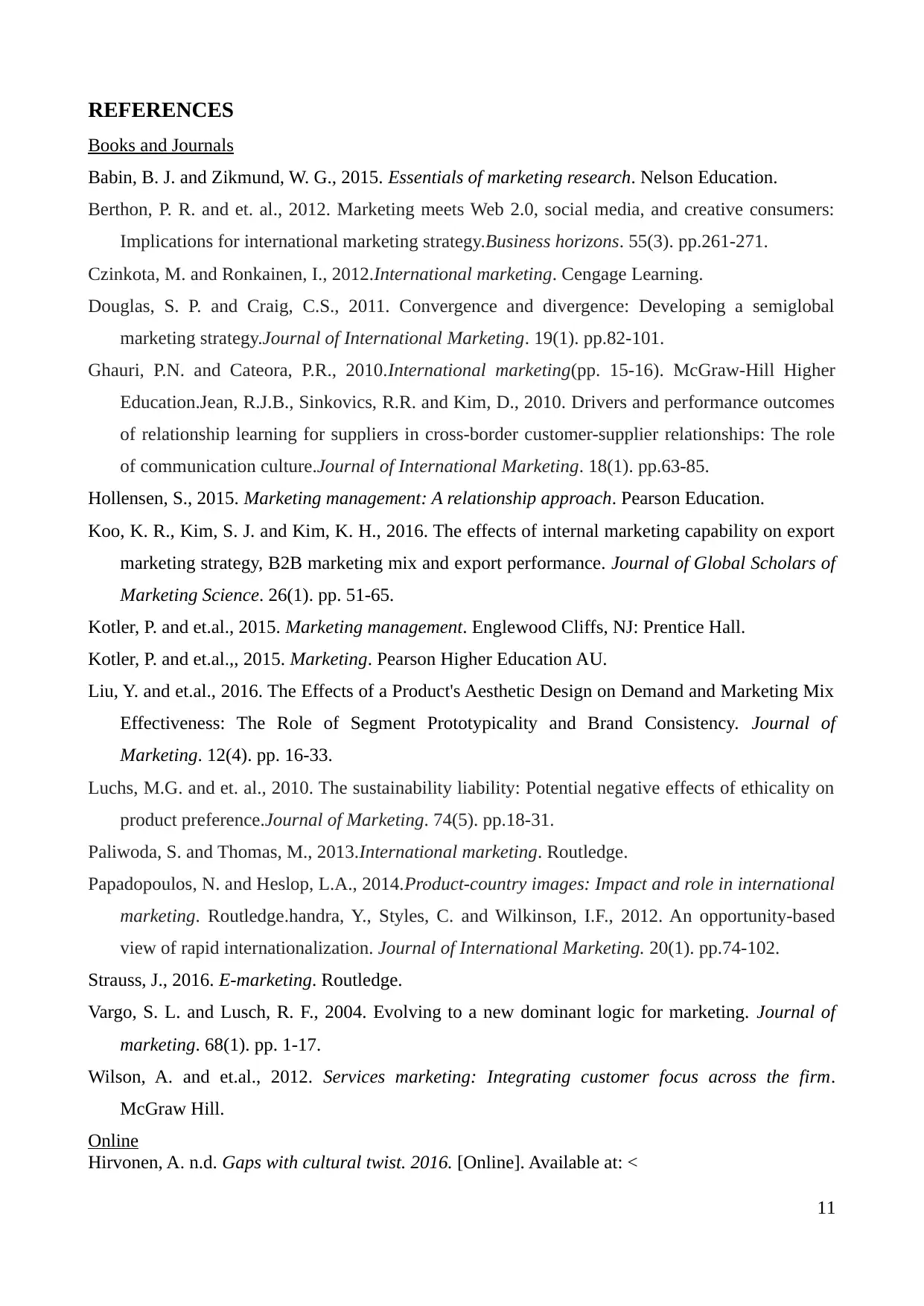
REFERENCES
Books and Journals
Babin, B. J. and Zikmund, W. G., 2015. Essentials of marketing research. Nelson Education.
Berthon, P. R. and et. al., 2012. Marketing meets Web 2.0, social media, and creative consumers:
Implications for international marketing strategy.Business horizons. 55(3). pp.261-271.
Czinkota, M. and Ronkainen, I., 2012.International marketing. Cengage Learning.
Douglas, S. P. and Craig, C.S., 2011. Convergence and divergence: Developing a semiglobal
marketing strategy.Journal of International Marketing. 19(1). pp.82-101.
Ghauri, P.N. and Cateora, P.R., 2010.International marketing(pp. 15-16). McGraw-Hill Higher
Education.Jean, R.J.B., Sinkovics, R.R. and Kim, D., 2010. Drivers and performance outcomes
of relationship learning for suppliers in cross-border customer-supplier relationships: The role
of communication culture.Journal of International Marketing. 18(1). pp.63-85.
Hollensen, S., 2015. Marketing management: A relationship approach. Pearson Education.
Koo, K. R., Kim, S. J. and Kim, K. H., 2016. The effects of internal marketing capability on export
marketing strategy, B2B marketing mix and export performance. Journal of Global Scholars of
Marketing Science. 26(1). pp. 51-65.
Kotler, P. and et.al., 2015. Marketing management. Englewood Cliffs, NJ: Prentice Hall.
Kotler, P. and et.al.,, 2015. Marketing. Pearson Higher Education AU.
Liu, Y. and et.al., 2016. The Effects of a Product's Aesthetic Design on Demand and Marketing Mix
Effectiveness: The Role of Segment Prototypicality and Brand Consistency. Journal of
Marketing. 12(4). pp. 16-33.
Luchs, M.G. and et. al., 2010. The sustainability liability: Potential negative effects of ethicality on
product preference.Journal of Marketing. 74(5). pp.18-31.
Paliwoda, S. and Thomas, M., 2013.International marketing. Routledge.
Papadopoulos, N. and Heslop, L.A., 2014.Product-country images: Impact and role in international
marketing. Routledge.handra, Y., Styles, C. and Wilkinson, I.F., 2012. An opportunity-based
view of rapid internationalization. Journal of International Marketing. 20(1). pp.74-102.
Strauss, J., 2016. E-marketing. Routledge.
Vargo, S. L. and Lusch, R. F., 2004. Evolving to a new dominant logic for marketing. Journal of
marketing. 68(1). pp. 1-17.
Wilson, A. and et.al., 2012. Services marketing: Integrating customer focus across the firm.
McGraw Hill.
Online
Hirvonen, A. n.d. Gaps with cultural twist. 2016. [Online]. Available at: <
11
Books and Journals
Babin, B. J. and Zikmund, W. G., 2015. Essentials of marketing research. Nelson Education.
Berthon, P. R. and et. al., 2012. Marketing meets Web 2.0, social media, and creative consumers:
Implications for international marketing strategy.Business horizons. 55(3). pp.261-271.
Czinkota, M. and Ronkainen, I., 2012.International marketing. Cengage Learning.
Douglas, S. P. and Craig, C.S., 2011. Convergence and divergence: Developing a semiglobal
marketing strategy.Journal of International Marketing. 19(1). pp.82-101.
Ghauri, P.N. and Cateora, P.R., 2010.International marketing(pp. 15-16). McGraw-Hill Higher
Education.Jean, R.J.B., Sinkovics, R.R. and Kim, D., 2010. Drivers and performance outcomes
of relationship learning for suppliers in cross-border customer-supplier relationships: The role
of communication culture.Journal of International Marketing. 18(1). pp.63-85.
Hollensen, S., 2015. Marketing management: A relationship approach. Pearson Education.
Koo, K. R., Kim, S. J. and Kim, K. H., 2016. The effects of internal marketing capability on export
marketing strategy, B2B marketing mix and export performance. Journal of Global Scholars of
Marketing Science. 26(1). pp. 51-65.
Kotler, P. and et.al., 2015. Marketing management. Englewood Cliffs, NJ: Prentice Hall.
Kotler, P. and et.al.,, 2015. Marketing. Pearson Higher Education AU.
Liu, Y. and et.al., 2016. The Effects of a Product's Aesthetic Design on Demand and Marketing Mix
Effectiveness: The Role of Segment Prototypicality and Brand Consistency. Journal of
Marketing. 12(4). pp. 16-33.
Luchs, M.G. and et. al., 2010. The sustainability liability: Potential negative effects of ethicality on
product preference.Journal of Marketing. 74(5). pp.18-31.
Paliwoda, S. and Thomas, M., 2013.International marketing. Routledge.
Papadopoulos, N. and Heslop, L.A., 2014.Product-country images: Impact and role in international
marketing. Routledge.handra, Y., Styles, C. and Wilkinson, I.F., 2012. An opportunity-based
view of rapid internationalization. Journal of International Marketing. 20(1). pp.74-102.
Strauss, J., 2016. E-marketing. Routledge.
Vargo, S. L. and Lusch, R. F., 2004. Evolving to a new dominant logic for marketing. Journal of
marketing. 68(1). pp. 1-17.
Wilson, A. and et.al., 2012. Services marketing: Integrating customer focus across the firm.
McGraw Hill.
Online
Hirvonen, A. n.d. Gaps with cultural twist. 2016. [Online]. Available at: <
11
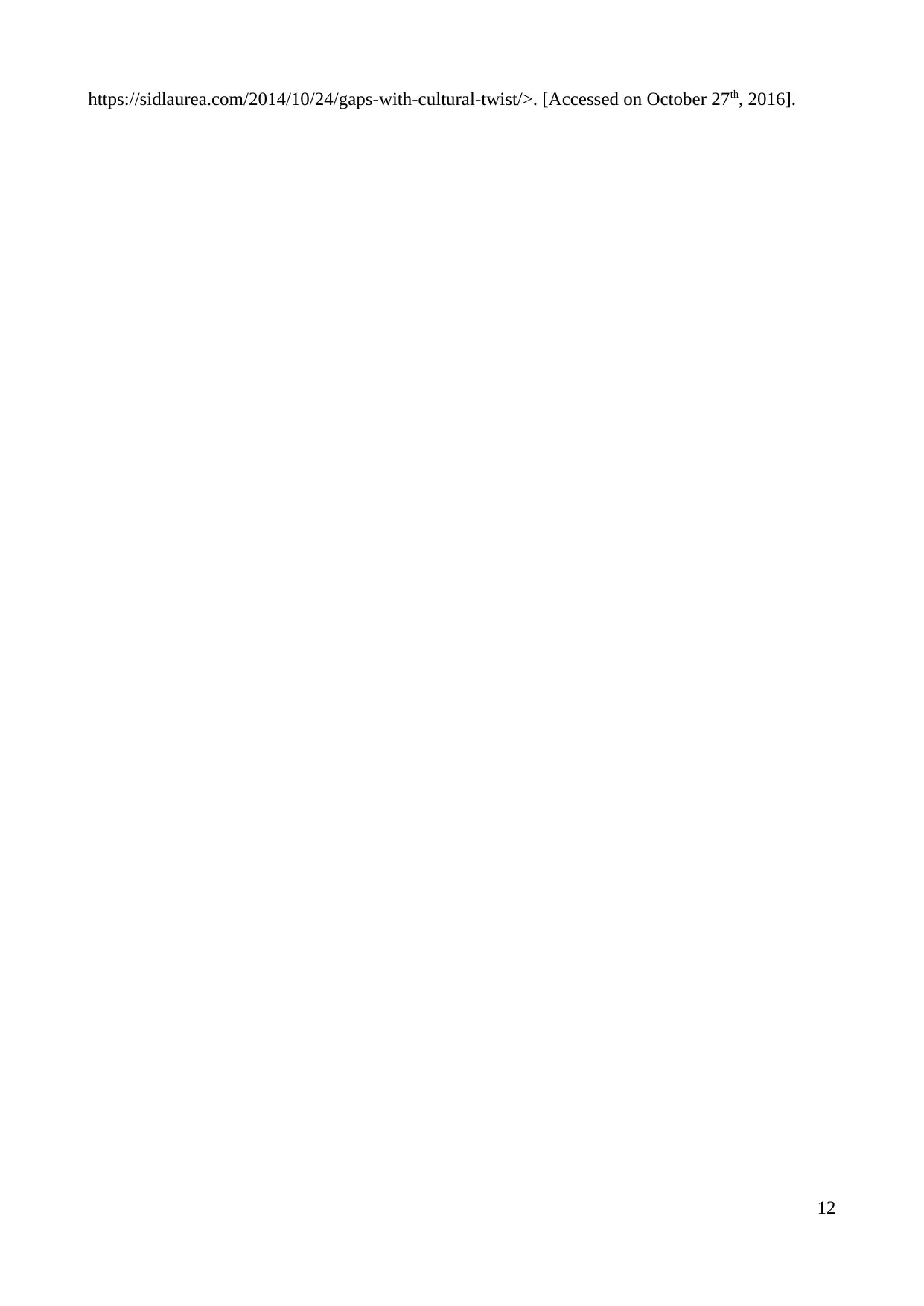
https://sidlaurea.com/2014/10/24/gaps-with-cultural-twist/>. [Accessed on October 27th, 2016].
12
12
⊘ This is a preview!⊘
Do you want full access?
Subscribe today to unlock all pages.

Trusted by 1+ million students worldwide
1 out of 12
Related Documents
Your All-in-One AI-Powered Toolkit for Academic Success.
+13062052269
info@desklib.com
Available 24*7 on WhatsApp / Email
![[object Object]](/_next/static/media/star-bottom.7253800d.svg)
Unlock your academic potential
Copyright © 2020–2025 A2Z Services. All Rights Reserved. Developed and managed by ZUCOL.





